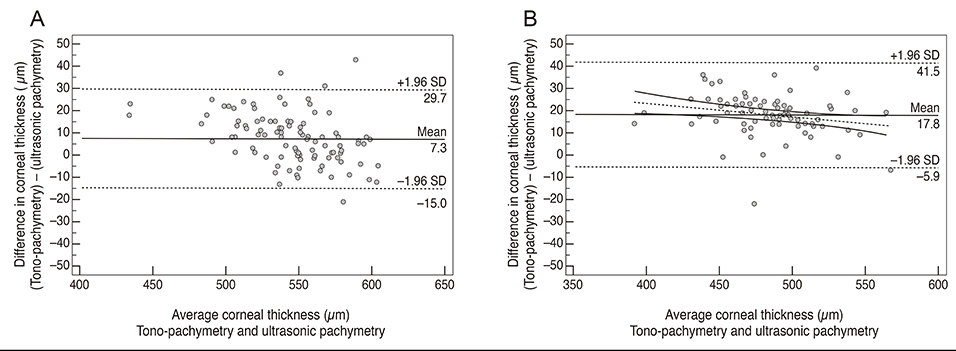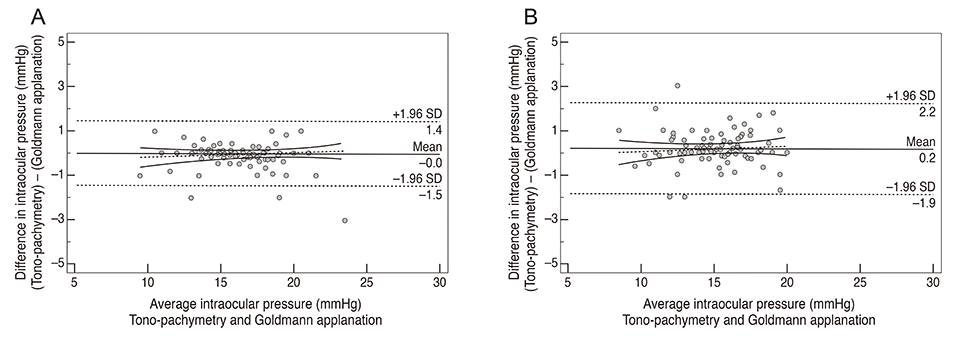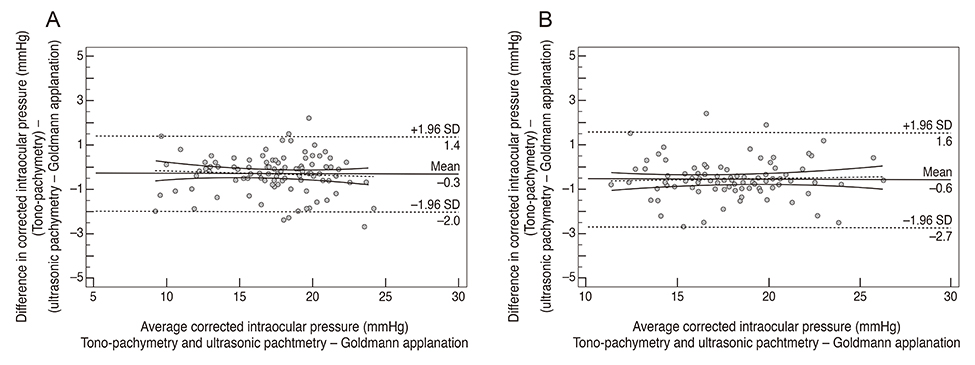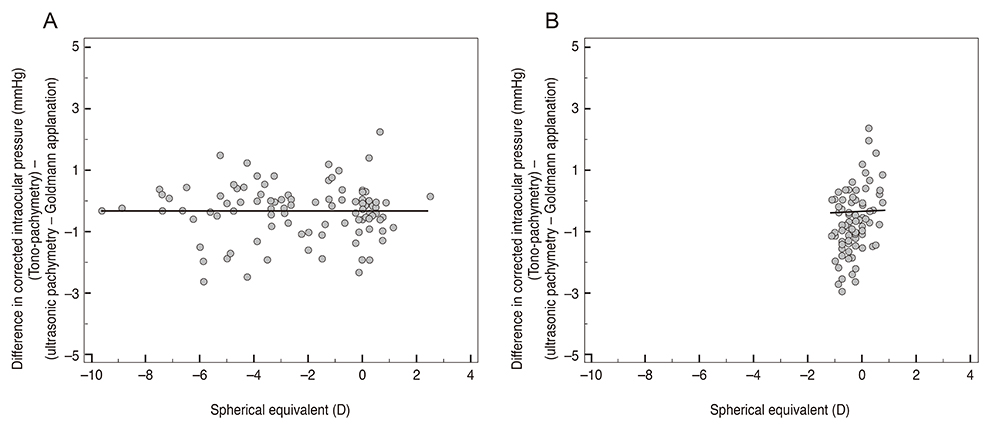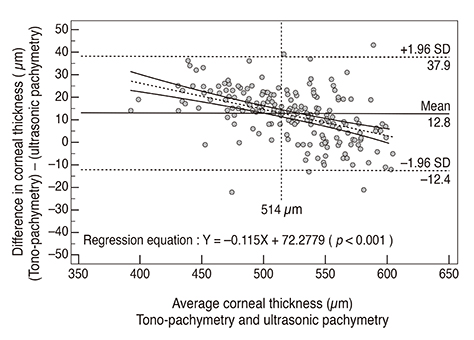Korean J Ophthalmol.
2017 Feb;31(1):44-51. 10.3341/kjo.2017.31.1.44.
Validity of Tono-pachymetry for Measuring Corrected Intraocular Pressure in Non-surgical and Post-photorefractive Keratectomy Eyes
- Affiliations
-
- 1Department of Ophthalmology, Asan Medical Center, University of Ulsan College of Medicine, Seoul, Korea. simdan@naver.com
- 2Department of Ophthalmology, Aerospace Medical Center, Republic of Korea Air Force, Cheongju, Korea.
- KMID: 2368678
- DOI: http://doi.org/10.3341/kjo.2017.31.1.44
Abstract
- PURPOSE
To assess the validity of central corneal thickness (CCT) and corrected intraocular pressure (IOP) values obtained by tono-pachymetry in non-surgical and post-photorefractive keratectomy (PRK) eyes.
METHODS
For the study, 108 young healthy participants and 108 patients who had PRK were enrolled. Measurements were randomly performed by tono-pachymetry, ultrasonic (US) pachymetry, and Goldmann applanation tonometry (GAT). CCT measurement by tono-pachymetry was compared to that of US pachymetry. The corrected IOP value obtained by tono-pachymetry was compared to that obtained by US pachymetry and GAT. The corrected IOP from US pachymetry and GAT was calculated using the identical compensation formula built into the tono-pachymetry. Bland-Altman plot and paired t-test were conducted to evaluate the between-method agreements.
RESULTS
The mean CCT measurement using tono-pachymetry was significantly greater by 7.3 µm in non-surgical eyes (p < 0.001) and 17.8 µm in post-PRK eyes (p < 0.001) compared with US pachymetry. Differences were significant in both Bland-Altman plotand paired t-test. The mean difference of corrected IOP values obtained by tono-pachymetry and calculated from measurements by US pachymetry and GAT was 0.33 ± 0.87 mmHg in non-surgical eyes and 0.57 ± 1.08 mmHg in post-PRK eyes. The differences in the Bland-Altman plot were not significant.
CONCLUSIONS
The CCT measurement determined using tono-pachymetrywas significantly thicker than that of US pachymetry. The difference in CCT was greater in post-PRK eyes than in non-surgical eyes. However, the corrected IOP value obtained by tono-pachymetry showed reasonable agreement with that calculated from US pachymetry and GAT measurements.
MeSH Terms
Figure
Reference
-
1. Ehlers N, Bramsen T, Sperling S. Applanation tonometry and central corneal thickness. Acta Ophthalmol (Copenh). 1975; 53:34–43.2. Whitacre MM, Stein RA, Hassanein K. The effect of corneal thickness on applanation tonometry. Am J Ophthalmol. 1993; 115:592–596.3. Stodtmeister R. Applanation tonometry and correction according to corneal thickness. Acta Ophthalmol Scand. 1998; 76:319–324.4. Doughty MJ, Zaman ML. Human corneal thickness and its impact on intraocular pressure measures: a review and meta-analysis approach. Surv Ophthalmol. 2000; 44:367–408.5. Bron AM, Creuzot-Garcher C, Goudeau-Boutillon S, d'Athis P. Falsely elevated intraocular pressure due to increased central corneal thickness. Graefes Arch Clin Exp Ophthalmol. 1999; 237:220–224.6. Mardelli PG, Piebenga LW, Whitacre MM, Siegmund KD. The effect of excimer laser photorefractive keratectomy on intraocular pressure measurements using the Goldmann applanation tonometer. Ophthalmology. 1997; 104:945–948.7. Gonzalez-Meijome JM, Cervino A, Yebra-Pimentel E, Parafita MA. Central and peripheral corneal thickness measurement with Orbscan II and topographical ultrasound pachymetry. J Cataract Refract Surg. 2003; 29:125–132.8. Williams R, Fink BA, King-Smith PE, Mitchell GL. Central corneal thickness measurements: using an ultrasonic instrument and 4 optical instruments. Cornea. 2011; 30:1238–1243.9. Sedaghat MR, Daneshvar R, Kargozar A, et al. Comparison of central corneal thickness measurement using ultrasonic pachymetry, rotating Scheimpflug camera, and scanning-slit topography. Am J Ophthalmol. 2010; 150:780–789.10. Fujimura F, Kamiya K, Fujiwara K, et al. Repeatability and reproducibility of measurements using a NT-530P noncontact tono/pachymeter and correlation of central corneal thickness with intraocular pressure. Biomed Res Int. 2013; 2013:370592.11. Garcia-Resua C, Pena-Verdeal H, Minones M, et al. Reliability of the non-contact tono-pachymeter Tonopachy NT-530P in healthy eyes. Clin Exp Optom. 2013; 96:286–294.12. Barkana Y, Gerber Y, Elbaz U, et al. Central corneal thickness measurement with the Pentacam Scheimpflug system, optical low-coherence reflectometry pachymeter, and ultrasound pachymetry. J Cataract Refract Surg. 2005; 31:1729–1735.13. Kohlhaas M, Boehm AG, Spoerl E, et al. Effect of central corneal thickness, corneal curvature, and axial length on applanation tonometry. Arch Ophthalmol. 2006; 124:471–476.14. Bland JM, Altman DG. Comparing methods of measurement: why plotting difference against standard method is misleading. Lancet. 1995; 346:1085–1087.15. Bland JM, Altman DG. Statistical methods for assessing agreement between two methods of clinical measurement. Lancet. 1986; 1:307–310.16. Portney LG, Watkins MP, editors. Foundations of clinical research: applications to practice. Upper Saddle River: Pearson/Prentice Hall;2009. p. 588–597.17. Schiano Lomoriello D, Lombardo M, Tranchina L, et al. Repeatability of intra-ocular pressure and central corneal thickness measurements provided by a non-contact method of tonometry and pachymetry. Graefes Arch Clin Exp Ophthalmol. 2011; 249:429–434.18. Han KE, Kim H, Kim NR, et al. Comparison of intraocular pressures after myopic laser-assisted subepithelial keratectomy: tonometry-pachymetry, Goldmann applanation tonometry, dynamic contour tonometry, and noncontact tonometry. J Cataract Refract Surg. 2013; 39:888–897.19. Amano S, Honda N, Amano Y, et al. Comparison of central corneal thickness measurements by rotating Scheimpflug camera, ultrasonic pachymetry, and scanning-slit corneal topography. Ophthalmology. 2006; 113:937–941.
- Full Text Links
- Actions
-
Cited
- CITED
-
- Close
- Share
- Similar articles
-
- The Incidence of Increased Intraocular Pressure when Using 0.1% Fluorometholone after Photorefractive Keratectomy
- Result of Schwind Excimer Photorefractive Keratectomy(One year follow up)
- The Differences of IOP and Factors Influencing IOP Measured by Goldmann Applanation Tonometer after Photore fractive Keratectomy and Laser In Situ Keratomileusis in Myopic Eyes between -4~-7 Diopters
- Comparison of Central Corneal Thickness Measured by Tono-pachymetry and Ultrasound Pachymetry
- Comperieon of the Tono-Pen and the Goldmann Applanation Tonometry in Csreening Test

